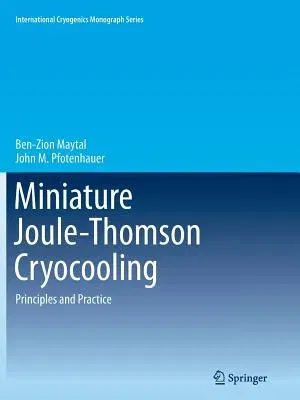This book is the first in English being entirely dedicated to
Miniature Joule-Thomson Cryocooling. The category of Joule-Thomson
(JT) cryocoolers takes us back to the roots of cryogenics, in 1895, with
figures like Linde and Hampson. The "cold finger" of these cryocoolers
is compact, lacks moving parts, and sustains a large heat flux
extraction at a steady temperature. Potentially, they cool down
unbeatably fast. For example, cooling to below 100 K (minus 173 Celsius)
might be accomplished within only a few seconds by liquefying argon. A
level of about 120 K can be reached almost instantly with krypton.
Indeed, the species of coolant plays a central role dictating the size,
the intensity and the level of cryocooling. It is the JT effect that
drives these cryocoolers and reflects the deviation of the "real" gas
from the ideal gas properties. The nine chapters of the book are
arranged in five parts.
-The Common Principle of Cyrocoolers shared across the broad
variety of cryocooler types
-Theoretical Aspects: the JT effect and its inversion, cooling
potential of coolants, the liquefaction process, sizing of heat
exchangers, level of pressurization, discharge of pressure vessels
- Practical Aspects: modes of operation (fast cooldown, continuous,
multi-staging, hybrid cryocoolers), pressure sources, configuration,
construction and technologies, flow adjustment, MEMS, open and closed
cycle, cooldown process and similarity, transient behavior
- Mixed Coolant cryocooling: theory, practice and applications
- Special Topics: real gas choked flow rates, gas purity, clog
formation, optimal fixed orifice, modeling, cryosurgical devices,
warming by the inverse JT effect
The theoretical aspects may be of interest not only to those working
with cryocoolers but also for others with a general interest in "real"
gas thermodynamics, such as, for example, the inversion of the JT effect
in its differential and integral forms, and the exceptional behavior of
the quantum gases.
A detailed list of references for each chapter comprises a broad
literature survey. It consists of more than 1,200 relevant publications
and 450 related patents. The systematically organized content, arranged
under a thorough hierarchy of headings, supported by 227 figures and 41
tables, and accompanied by various chronological notes of evolution,
enables readers a friendly interaction with the book.
Dr. Ben-Zion Maytal is a Senior Researcher at Rafael-Advanced Defense
Systems, Ltd., and an Adjunct Senior Teaching Fellow at the
Technion-Israel Institute of Technology, Haifa, Israel.
Prof. John M. Pfotenhauer holds a joint appointment in the Departments
of Mechanical Engineering and Engineering Physics at the University of
Wisconsin - Madison.

